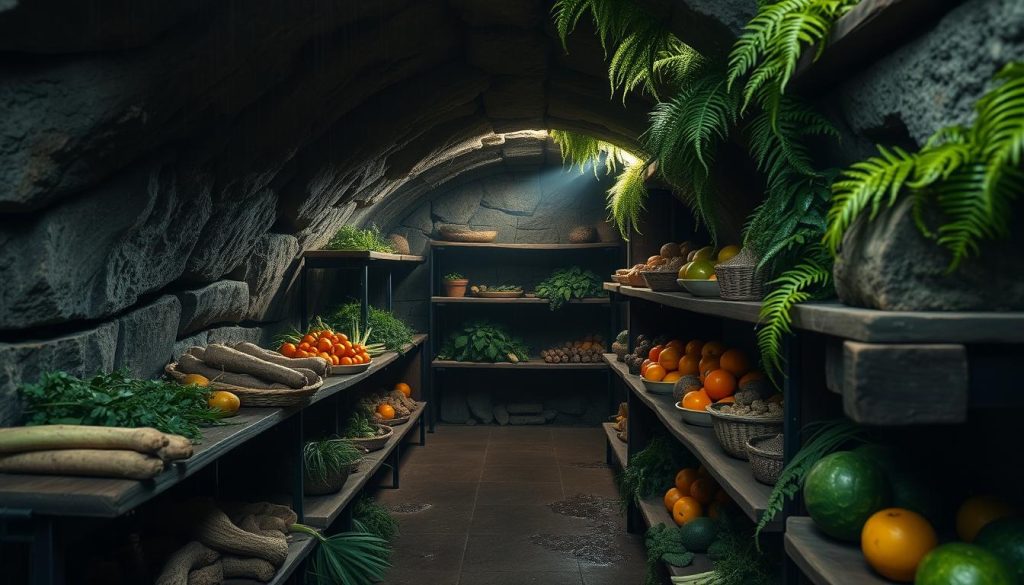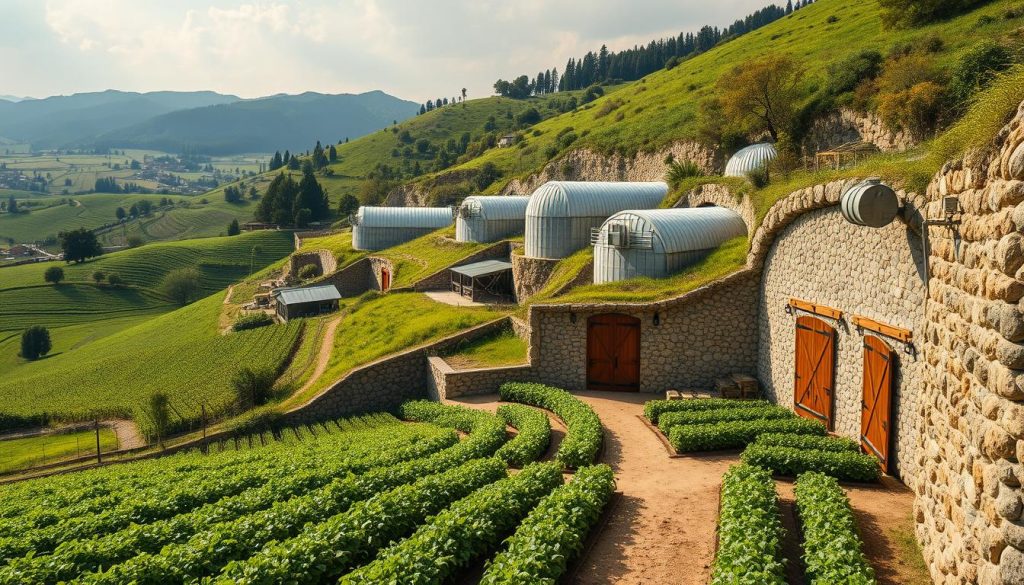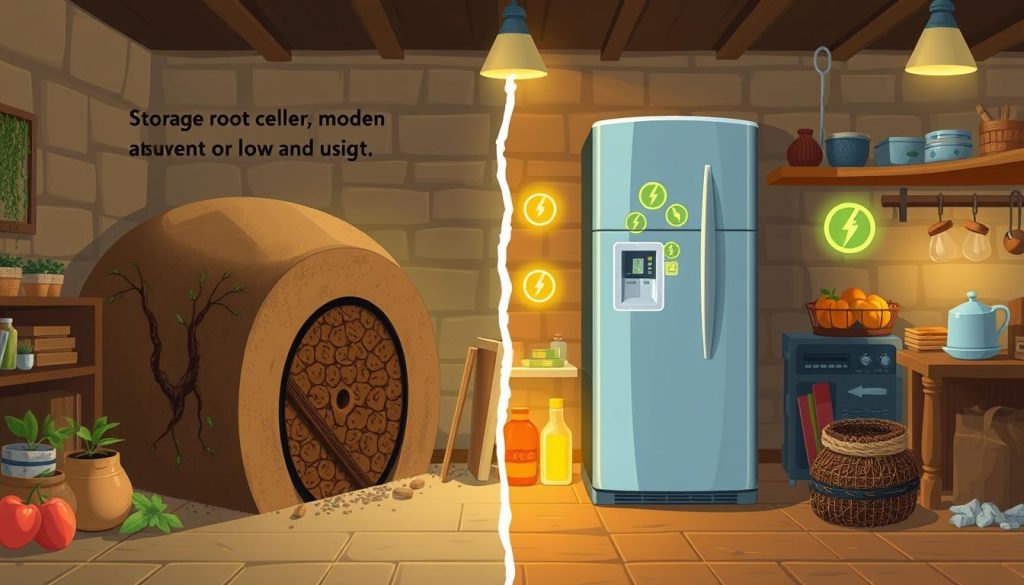In today’s fast world, keeping food fresh is key for businesses. Commercial root cellars offer top-notch storage solutions. They are built to meet the needs of different industries, keeping goods in perfect condition.
Commercial root cellars are different from old storage methods. They use advanced features for better storage. This makes food last longer and cuts down on waste. They are essential for many businesses, helping keep the supply chain running smoothly.
Understanding Commercial Root Cellars
Commercial root cellars are special underground storage places. They keep food fresh by controlling temperature and humidity. These are different from personal or old root cellars because they handle more food and have better control.
What Are Commercial Root Cellars?
Commercial root cellars are advanced underground structures. They use the natural coolness and humidity of the earth. This way, fruits, veggies, and even dairy stay fresh for a long time without needing artificial cooling.
Benefits of Using Root Cellars
Using commercial root cellars has many advantages. They use natural methods to keep food fresh, which saves energy. This also helps reduce food waste and keeps food fresh longer.
Key Features of Effective Storage Solutions

Commercial root cellars have key features that make them efficient. Knowing these can help businesses get the most out of climate-controlled storage.
Temperature Control Mechanisms
Keeping the right temperature is key to keeping goods fresh. Climate-controlled systems keep the temperature steady. This is important for stopping spoilage and keeping food’s nutritional value.
Humidity Levels and Their Importance
Keeping humidity at the right level is also crucial. The right humidity stops mold and mildew from growing. This makes stored items last longer. Systems that control humidity help keep it just right.
Insulation and Construction Materials
Using green materials in building root cellars is smart. These materials make the structure more energy-efficient. Good insulation keeps the inside stable, no matter the weather outside.
In short, climate-controlled storage is vital for businesses needing good storage. It combines advanced temperature control, the right humidity, and green materials. Together, they make commercial root cellars efficient and long-lasting.
Applications of Commercial Root Cellars

Commercial root cellars are key for keeping food safe and fresh for longer. They help in storing fruits and veggies, and are vital for big farms. These cellars are essential for many reasons.
Ideal for Food Preservation
Commercial root cellars are perfect for keeping food fresh. They keep the temperature and humidity just right. This helps food stay good for longer, cutting down on waste and keeping it healthy.
Use in Horticulture and Agriculture
Root cellars are great for farms too. They’re perfect for storing crops after they’re picked. This helps farmers manage their food better. Root cellars keep veggies and grains fresh for longer, helping farms succeed.
Comparison with Other Storage Methods

Looking at storage methods, we see the good and bad of root cellars and modern refrigeration. We look at energy use, cost, and new ways to store food. This helps us understand our options better.
Root Cellars vs. Refrigeration
Root cellars and refrigeration differ a lot in energy use. Root cellars cool naturally, using the earth’s temperature, saving energy. Refrigerators, on the other hand, need electricity to stay cool, costing more over time.
Building a root cellar costs more upfront because of the digging and materials needed. But, it saves money in the long run because it uses less energy than refrigerators.
Traditional Cellars vs. Modern Solutions
From old cellars to new storage, we’ve made big steps in keeping food fresh longer. Old cellars didn’t control temperature and humidity well, leading to spoilage. Now, we have better insulation, air systems, and temperature control, making food last longer and better.
These new storage ideas also focus on controlling moisture, key for keeping food fresh. They improve food preservation and are better for the environment. They use less energy and cut down on carbon emissions from old refrigerators.
Advantages of Investing in Root Cellars
Investing in commercial root cellars is a smart choice for sustainable and cost-effective storage. They offer a natural way to store food, saving money on energy and reducing waste. This makes them a great option for those looking to save in the long run.
Sustainability and Eco-Friendliness
Commercial root cellars are a green solution. They use the Earth’s natural insulation to keep food at the right temperature and humidity. This means they use less energy, helping to lower carbon emissions. They’re perfect for businesses that care about the environment.
Cost-Effectiveness Over Time
Root cellars are also cost-effective over time. They don’t need a lot of energy like refrigerators do, which saves money on bills and upkeep. This makes them a smart choice for saving money and being eco-friendly.
They also help keep food fresh longer, which means less waste. This adds to their value, making them a smart investment for businesses. They help save money and keep food fresh, which is good for both the wallet and the planet.
Choosing the Right Location
Choosing the right spot for a commercial root cellar is key. It affects how well it works and lasts. By picking the best location, we get the most out of it.
Site Selection Criteria
When picking a site, several things matter. Soil type, climate, and the land’s shape are important. They help keep the cellar cool and dry.
- Soil Composition: Good soil drains well. This stops moisture from building up and damaging food.
- Climate: The weather around the cellar affects its inside. A cool, steady climate means less need for cooling systems.
- Topography: Natural slopes are great for cellars. They add insulation and make getting in and out easier.
Accessibility Factors
It’s important to make sure getting to your root cellar is easy. This helps with moving goods around. Think about how close it is to roads and the layout of your land.
- Proximity to Transportation Networks: Being near roads, railways, or ports helps move goods faster.
- Overall Layout: The cellar should be easy to get to. This way, it doesn’t get in the way of other activities on your land.
When choosing a site, balance is key. We need to think about both the location and how easy it is to get to. This makes the cellar work better and last longer.
Maintenance and Care for Root Cellars
Keeping your root cellar in good shape is key. It needs regular care and clean storage practices. This guide will help you keep your root cellar clean and working well. It also covers how to fix common problems.
Cleaning and Upkeep Tips
Regular cleaning is vital for a root cellar. Here’s how to keep it in top condition:
- First, remove any old or bad produce to stop mold and bacteria.
- Then, clean walls, shelves, and floors with a mild bleach solution for cleanliness.
- Make sure ventilation is clear to keep air flowing well.
- Check the insulation for damage and fix or replace it if needed.
By watching these areas, you’ll keep your root cellar healthy and efficient.
Troubleshooting Common Issues
Even with good care, problems can still happen. Here are ways to fix them:
- Moisture Control: Use a dehumidifier if it’s too wet. Also, make sure water can’t get in by fixing drainage.
- Pest Management: Look for pests like rodents or insects often. Seal any holes and use safe pest control to protect your food.
Following these tips will help you handle and fix common problems. This ensures your root cellar stays useful and reliable.
Case Studies: Successful Implementations
Looking into the effects of commercial root cellars, we find real success stories. These stories show how these storage solutions have brought new efficiency and success to food cooperatives and farms. By examining these examples, we learn the best ways to store food, showing us how to succeed in storage.
Food Cooperatives Utilizing Root Cellars
Food cooperatives all over the country are using commercial root cellars to improve their work. They share resources and work together, making root cellars more valuable. For example, the Park Slope Food Coop in Brooklyn, New York, has seen a big drop in food waste.
They keep food fresh longer, making members happier. This also brings the community closer together, creating a strong bond between members and their food storage.
Agricultural Ventures Maximizing Storage
Farms are also seeing big benefits from root cellars. Earthbound Farm in California is a great example. They use root cellars to keep organic produce fresh for longer.
By focusing on the best storage practices, they keep their produce quality high. This shows how root cellars can help farms keep a steady supply of fresh food.
Future Trends in Commercial Root Cellars
The world of commercial root cellars is changing fast. New tech and the need for better storage are driving these changes. These updates are key for keeping food fresh and safe, even as the weather changes.
Innovations in Design and Technology
Smart systems are now a big part of root cellar tech. They control temperature and humidity, making storage easier. Also, green building materials are being used more, cutting down on waste and keeping things cool.
Things like automated vents and solar power for temperature control are making root cellars better. They show what’s possible in modern storage.
The Impact of Climate Change on Storage Needs
Climate change is making farming harder, and we need better storage. Weather shifts can mess up crops, making it harder to keep food fresh. New root cellar tech helps keep food good for longer, even with the weather’s ups and downs.
In short, the future of root cellars is all about staying ahead with tech. By using these new tools, we can keep food safe and fresh, even when the weather is unpredictable.

